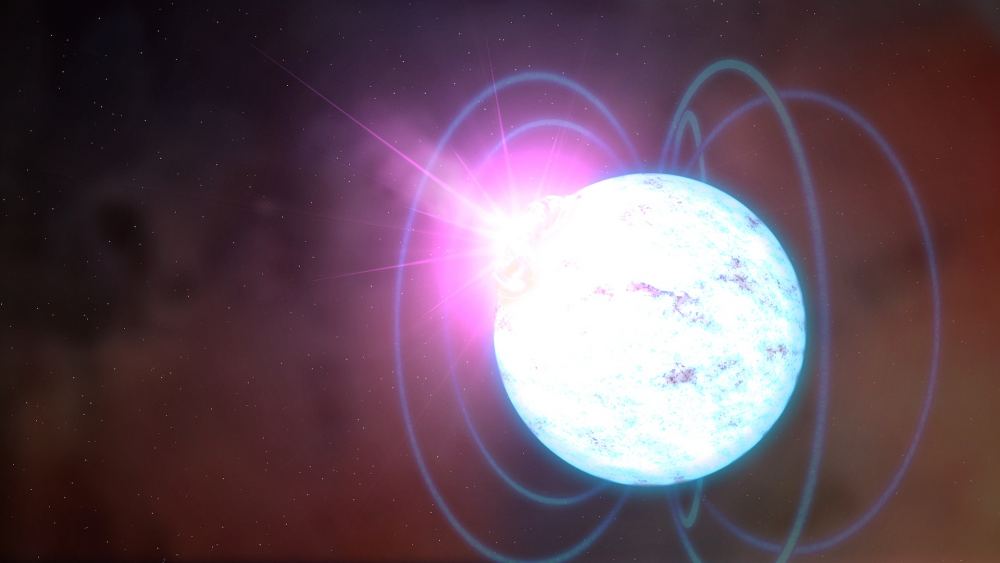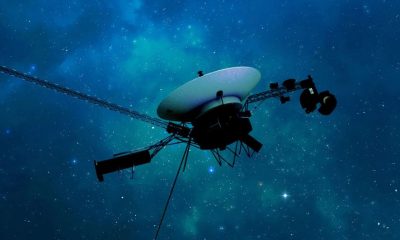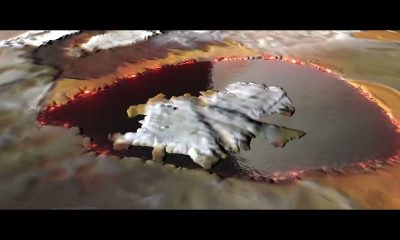News
Neutron Stars Can Have a Maximum Mass of 2.25 Solar Masses

When stars grow old and die, their mass determines their ultimate fate. Many supermassive stars have futures as neutron stars. But, the question is, how massive can their neutron stars get? That’s one that Professor Fan Yizhong and his team at Purple Mountain Observatory in China set out to answer.
It turns out that a non-rotating neutron star can’t be much more than 2.25 solar masses. If it was more massive, it would face a much more dire fate: to become a black hole. To figure this out, the team at Purple Mountain looked into what’s called the Oppenheimer limit. That’s the critical gravitational mass (abbreviated MTOV) of a massive object. If a neutron star stays below that Oppenheimer limit, it will remain in that state. If it grows more massive, then it collapses into a black hole.

Understanding the Physics of a Neutron Star
So, why determine the upper mass of a neutron star? The Oppenheimer limit for these objects has some implications for both astrophysics and nuclear physics. Essentially, it indicates that compact objects with masses greater than 2.25 solar masses are probably what scientists term the “lightest” black holes. Those objects would likely exist in a range of 2.5 to 3 solar masses.
The whole thing is rooted in the way that stars age. Everything depends on their starting mass. So, for example, our Sun is a lower-mass yellow dwarf and it will take more than 10 billion years to go through its whole life cycle. It’s about 4.5 billion years old now. As it ages, it will consume heavier elements in its core, which will heat it up. That drives expansion, which means the Sun will become a red giant and cast off its outer layers beginning in about five billion years. Eventually, it will shrink to become a white dwarf. That tiny object will contain less than the mass of the Sun, although some white dwarfs can be slightly more massive.
How a Neutron Star Forms
Stars much more massive than the Sun go through the same cycle, but they end their lives in supernova explosions. What’s left becomes a black hole. Or, if there’s not quite enough mass left after the explosion, the remnant becomes a neutron star. So, that means there’s a delicate line between it and a black hole. That line is the Oppenheimer limit.

Stars between 8 and 25 solar masses produce neutron stars. Something called “neutron degeneracy pressure” holds those odd remnants together. The leftover core of the star compresses after the supernova explosion. But, neutrons and protons in atomic nuclei in the core get pushed tightly together and they can’t be compressed any more. So, the system goes into a weird equilibrium. At that point, the resulting neutron star is approaching the Oppenheimer limit. If the object gains (or has) any more mass, that puts it over the limit. The result is a black hole.
Refining the Oppenheimer Limit for Neutron Stars
Professor Fan’s team worked to find a more precise value for the Oppenheimer Limit. To do this, they gathered data from such observations as those made by the Laser Interferometer Gravitational-Wave Observatory (LIGO) and the VIRGO gravitational wave detector, as well as an instrument aboard the International Space Station called The Neutron Star Interior Composition Explorer Mission (NICER). These and other missions detect the effects of neutron star collisions and neutron star-black hole encounters. NICER, in particular, studies the timing of x-ray emissions at neutron stars and works to answer the question: How big is a neutron star? By knowing the size and mass of neutron stars, astronomers can gain a further understanding of their formation and the exotic matter they contain.
The team incorporated information about the maximum mass cutoff (i.e. what’s the highest level of mass a neutron star can have) inferred from the distribution of these objects. They used models of the equation of state in their work. The equation of state basically looks at the state of matter in the neutron star (and black hole) and the models describe the parameters under which it exists (including pressure, volume, and temperature). The result of their work gives not only an upper bound to the mass of the neutron star (~2.5 solar masses) but also reveals that such a neutron star would have a radius of around 11.9 kilometers.
It’s interesting to see the precision in these measurements and models, based on actual data from multi-messenger observations of gravitational waves and soft X-ray emissions. Fan and the team suggest in the paper they published about their work that the objects with masses between 2.5 and 3 solar masses (detected by second-generation gravitational wave detectors) are most likely the lightest black holes.
Further Implications
The work also has some pretty interesting implications for cosmology, in particular the Hubble Constant. That’s the value assigned to the rate at which the Universe is expanding. It lies somewhere around 70 kilometers per second per megaparsec (plus or minus 2.2 km/sec/Mpc). The numbers depend on which methods astronomers use to calculate them.
The Fan team’s work suggests that the mass cutoff for neutron stars detected by gravitational waves should align with MTOV. That does not change with redshift. The Oppenheimer Limit mass cutoff is associated with both the redshifted mass of the object and its redshift. That’s predicted by the cosmological model and luminosity distance. This provides a new method to test the underlying cosmological model of the Universe. The current model begins with the Big Bang, inflation, and expansion. It also includes the distribution of all the matter (including dark and baryonic matter), and in corporates the contribution of dark energy.
For More Information
Maximum mass of non-rotating neutron star precisely inferred to be 2.25 solar masses
Maximum gravitational mass MTOV = 2.25 +0.08/-0.07 Ms inferred at about 3% precision with multimessenger data of neutron stars
ArXiv Preprint
News
University of Wisconsin-Milwaukee and Protesters reach an agreement to dismantle encampment

Protesters at the University of Wisconsin-Milwaukee have agreed to end their pro-Palestinian encampment following an agreement reached with the school, university officials announced on Sunday. The encampment, which had been in place for two weeks, will be dismantled by Tuesday, marking the end of what was believed to be the last standing encampment at a Wisconsin college.
University officials had allowed the encampment to remain on a patch of lawn between Mitchell Hall and a busy thoroughfare on the campus’s southern boundary, opting not to involve law enforcement. This approach differed from the response at the University of Wisconsin-Madison, where police were called in to remove tents after negotiations fell through. Despite initial efforts to disband the encampment, Wisconsin-Madison eventually reached an agreement with protesters to voluntarily dismantle the camp prior to commencement ceremonies.
Chancellor Mark Mone of Wisconsin-Milwaukee stated last Wednesday that the university had exhibited “the widest possible amount of patience and restraint.” However, he also cautioned that patience was wearing thin and hinted at potential action by the school. Following discussions with the UWM Popular University for Palestine Coalition, the university agreed to advocate for a cease-fire between Israel and Hamas, condemn the destruction of schools and universities in Gaza by Israeli forces, and hold meetings with protest leaders regarding university investments.
Additionally, the university pledged to urge the Water Council, a Milwaukee organization of water technology companies, to sever connections with two Israeli government-owned entities, Mekorot and the Israel Innovation Authority. Chancellor Mone serves as the treasurer on the Water Council’s board of directors.
In return for these commitments, the protesters agreed to dismantle the encampment beginning on Sunday and completing the process by Tuesday. They also agreed not to disrupt the university’s commencement ceremonies scheduled for Sunday. In a statement, the protesters expressed their satisfaction with the agreement, stating, “After hard fought edits and careful consideration by the coalition, we determined we had obtained all possible benefits from the encampment.”
The resolution of the encampment at the University of Wisconsin-Milwaukee represents a successful outcome of negotiations between university officials and protesters. By reaching a compromise that addresses the concerns of both parties, a peaceful resolution has been achieved, allowing for the encampment to be taken down without incident.
-

 News3 weeks ago
News3 weeks agoVoyager 1 Communications Restored by NASA
-

 News3 weeks ago
News3 weeks agoIs now the right time to invest in gold as prices have cooled?
-

 Entertainment3 weeks ago
Entertainment3 weeks agoKim Kardashian completes strange task before having her coffee
-

 News5 hours ago
News5 hours agoUniversity of Wisconsin-Milwaukee and Protesters reach an agreement to dismantle encampment
-

 Entertainment5 hours ago
Entertainment5 hours agoOlivia Munn opens up about her decision to have a full hysterectomy during breast cancer fight: ‘It was the right choice for me’













